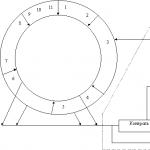Consumer market individuals and households. Consumer purchasing behavior. Buyer behavior patterns
Lecture 12
BUYER BEHAVIOR MODELS
The key question for marketing managers is: How exactly do consumers respond to the different marketing techniques that a firm might employ? A company that has truly understood how consumers react to various product characteristics, prices, and advertising arguments has a huge advantage over its competitors.
Marketing incentives and other stimuli penetrate the buyer's mind and cause certain responses. Marketing incentives include four elements: product, price, distribution and promotion methods. Other stimuli are the main forces and events of the economic, scientific, technical, political and cultural environment surrounding the buyer. In the buyer's mind, these stimuli cause consumer reactions: choice of product, company, dealer, time and volume of purchase.
The consciousness of each buyer has certain characteristics. These features—customer characteristics—have a major influence on how a person perceives and responds to stimuli.
The consumer market is defined as individuals and households purchasing or otherwise acquiring goods and services for personal consumption.
Consumer purchases are greatly influenced by cultural, social, personal and psychological factors.
Factors of culture. Cultural factors have the largest and most profound influence on consumer behavior. Culture is the root cause that determines human needs and behavior. From the moment of birth, a child acquires a basic set of values, preferences, manners and actions characteristic of his family and the main institutions of society.
Subculture. Any culture includes smaller components, or subcultures, that provide its members with the opportunity to more specifically identify and communicate with their own kind. In large communities there are groups of people of the same nationality, say, Ukrainians, Tatars, Germans or Azerbaijanis, who display clear ethnic tastes and interests. Separate subcultures with their own specific preferences and prohibitions are religious groups, such as groups of Orthodox Christians, Catholics, and Muslims. There are also subcultures of geographical areas.
Social status. In almost every society there are various social classes, which can be defined as follows.
Social classes – These are relatively stable groups within society, which are arranged in a hierarchical order and are characterized by the similarity of value ideas, interests and behavior of their members.
In the United States, for example, sociologists distinguish six social classes. In Russia, during the transition period, the class structure is just being formed.
Social classes have several characteristics. Individuals belonging to the same class tend to behave in almost the same way. Social class is defined on the basis of occupation, income, wealth, education, value orientation and similar characteristics. Each social class has its own preferences in clothing, household supplies, leisure activities, and car brands.
Social factors. Consumer behavior is also determined by social factors, such as reference groups, family, social roles and statuses.
Reference groups. Human behavior is especially strongly influenced by numerous reference groups. Reference groups – these are groups that have both direct and indirect influence on a person's attitudes or behavior. These are the groups to which an individual belongs and with which he interacts - family, friends, neighbors and work colleagues.
Reference groups influence people in three ways. Firstly, the individual is faced with new behavior and lifestyle. Secondly, the group affects the individual's attitudes and self-image, since he, as a rule, strives to “fit in” with the group. Thirdly, the group pushes the individual towards conformity.
Family. Family members can have a strong influence on buyer behavior. From parents a person receives instructions about religion, politics, economics, ambition, self-respect, love. A more direct influence on everyday purchasing behavior is exerted by an individual's spouse and children. The family is the most important consumer purchasing organization within society. The ratio of influence between husband and wife varies widely depending on the product category.
Social roles and statuses. An individual is a member of many social groups. His position in each of them can be characterized in terms of role and status. Let's say, in relation to his parents he plays the role of a son or daughter, in his own family - the role of a wife or husband, within the company - the role of a director. Role represents a set of actions that those around him expect from an individual. Each of the roles played by a person will in one way or another influence his purchasing behavior.
Each role corresponds to a specific status, reflecting the degree of positive assessment of it by society. The role of a director has a higher status compared to the role of a son or daughter. As a director, a person acquires clothes, a car, a watch, which reflect precisely this role and its status. The buyer often opts for goods by which his status in society is judged.
Personal factors. The buyer's decisions are also influenced by his personal external characteristics, especially such as age, stage of the family life cycle, occupation, economic status, lifestyle, personality type and self-image.
Age and stage of the family life cycle. Over time, changes occur in the range and range of goods and services purchased by people. In the first years of life, a person needs baby food products. During the years of growing up and maturity, he eats a wide variety of foods; in old age, he eats special dietary foods. Over the years, his tastes in clothing, furniture, recreation and entertainment also change.
The nature of consumption depends on the stage of the family life cycle. They experience certain transitional periods in their lives, periods of transformation. It is necessary to take into account the changing consumer interests that are associated with transition periods in the life of an adult.
Occupation. A person’s occupation has a certain influence on the choice of goods and services purchased by a person. For example, a worker buys himself work clothes, work shoes, the president of a company buys expensive suits. The worker uses cheaper modes of transport, the president of the company travels by plane, becomes a member of privileged clubs, etc. It is necessary to identify groups by occupation whose members show increased interest in the company’s products and services. You can specialize in the production of goods for a specific professional group.
Economic situation. The economic situation of an individual greatly affects his product choice. It is determined by the size of the expenditure portion of income, his savings, and creditworthiness. When offering products that are marketed based on consumer income, you need to monitor trends in income, savings, and interest rates. If economic indicators indicate a recession, it is necessary to change the product, its positioning and price, reduce production volumes and inventories.
Lifestyle. Individuals belonging to the same subculture, the same social class, and even the same occupation can lead completely different lifestyles. For example, a woman may prefer the life of a skilled housewife, a businesswoman, or a carefree person. She can play several roles at the same time. This is a way of life - established forms of human existence in the world, which are expressed in his activities, interests and beliefs. It is necessary to identify the relationship between a product and a lifestyle.
Personality type and self-image. A person’s purchasing behavior is greatly influenced by his personality type, i.e. a set of distinctive psychological characteristics that provide relative consistency and constancy in human responses to the environment.
Personality type is usually described on the basis of such inherent traits as self-confidence, wariness, influence, affection, independence, aggressiveness, fickleness, etc. Knowing personality type is useful in analyzing consumer behavior when there is a certain connection between personality types and product choice.
Psychological factors. An individual’s purchasing choice is also influenced by four main psychological factors: motivation, perception, learning, belief and attitude.
Motivation. At any given time, a person experiences various needs. Some are a consequence of such states of internal physiological tension as hunger, thirst, discomfort, others are a consequence of such states of internal psychological tension as the need for recognition and spiritual intimacy. A need that has reached a sufficiently high level of intensity becomes a motive.
Motive(or motivation) - a need that has become so urgent that it forces a person to look for ways and means to satisfy it. Satisfying a need reduces the internal tension experienced by an individual.
Psychologists have developed a number of theories of human motivation. The most popular of them is theory Sigmund Freud and theory Abraham Maslow.
Freud believed that people are generally unaware of the real psychological forces that shape behavior, that a person grows by suppressing many drives. These urges never completely disappear and are never completely under control. Thus, a person is not fully aware of the origins of his own motivation.
Motivation researchers have made a number of interesting, and sometimes strange, conclusions regarding what can influence the consumer’s mind when making certain purchases. Thus, they believe that men smoke cigars as an adult alternative to thumb sucking.
Abraham Maslow believes that human needs are ranked in order of importance in a hierarchical order: first physiological needs, then self-preservation needs, social needs, esteem needs, and finally self-affirmation needs. A person will strive to satisfy the most important needs first. As soon as he manages to satisfy some important need, it temporarily ceases to be the driving motive. At the same time, an impulse appears to satisfy the next most important need. For example, a starving person is not interested in events happening in the world of art and politics.
Perception. A motivated person is ready for action. The nature of his action depends on how he perceives the situation. Two different people, being equally motivated, in the same objective situation can act differently, since they perceive this situation differently. For example, one may perceive a talkative salesman as an arrogant person, while another may perceive this salesperson as helpful.
Perception can be defined as the process by which an individual selects, organizes and interprets incoming information to create a meaningful picture of the world around him.
Perception is always selective. A person is simply not able to respond to all stimuli. He weeds out most of them. People tend to notice stimuli that are related to the needs they currently have, or those that they expect, or that are unusual.
Even irritants noticed by the consumer are not necessarily perceived by him as intended by the sender. Selective distortion occurs. A person strives to fit incoming information into the framework of his existing opinions. Selective distortion refers to the tendency of people to transform information, giving it personal significance. People tend to interpret information in ways that support rather than challenge their existing ideas and judgments.
A person does not remember all the information received. Memorization is also selective. A person simply forgets much of what he learns. He tends to remember only information that supports his attitudes and beliefs. It must be borne in mind that most people immediately “mechanically” and briefly remember a very small amount of information - a few words, a few simple images.
Consumer market - individuals and households purchasing or otherwise acquiring goods and services for personal consumption.
A detailed model of consumer behavior is presented in Fig. 5.1.
Fig.5.1. Detailed model of purchasing behavior
Let's present the buyer's characteristics in the form of a diagram (Fig. 5.2.)
Rice. 5.2. Buyer characteristics
Let's take a closer look at some of the factors.
The human life cycle includes the following stages:
1. Stage of single life (young singles living separately from their parents).
2. Young newlyweds without children.
3. “Full nest” first stage (the youngest child is less than six years old).
4. “Full nest” second stage (the youngest child is six years old or more).
5. “Full nest” third stage (elderly spouses with children in their care).
6. “Empty nest” first stage (elderly spouses, whose children already live separately, the head of the family works).
7. “Empty nest” second stage (elderly spouses whose children live separately, the head of the family is retired).
8. The widower works.
9. Retired widower.
The personality type that characterizes one’s own “I” is usually described on the basis of such inherent traits as influence, independence, fickleness, respectfulness, lust for power, sociability, wariness, affection, aggressiveness, self-control, desire for success, love of order, adaptability.
The marketer must strive to create a brand image that matches the self of the members of the target market.
Of the psychological factors, let us dwell on the concept of motive. The motive is a need that has become so urgent that it forces a person to look for ways and means to satisfy it.
There are several theories of behavioral motivation.
1. Freud's theory of motivation, in which he argues that people are generally unaware of the real psychological forces that shape their behavior, suppressing many drives. However, it is never possible to completely suppress a person’s desires, because... suppression necessarily manifests itself in neurotic behavior, obsessive states, and psychoses.

2. Maslow's theory of motivation attempts to explain why some people spend a lot of time on self-preservation, while others spend a lot of time on gaining the respect of others? He developed a hierarchy of needs (Fig. 5.3.), in which human needs are arranged in order of importance from most to least urgent. As soon as a person manages to satisfy some important need, it temporarily ceases to be a driving motive and an impulse appears to satisfy the next most important need.
Rice. 5.3. Maslow's Hierarchy of Needs
The factors listed in the diagram (Fig. 5.2.) give an idea of how to more effectively attract and serve customers.
As a result of collecting information, consumer awareness of the brands of goods available on the market and their properties increases. In practical terms, a firm must develop a marketing mix that introduces its brand into both consumer awareness and choice. If the product fails to penetrate these bundles, the firm will miss the opportunity to sell its product.
The sequence of packages involved in the purchasing decision-making process is presented in Figure 5.4.
Fig.5.4. Sequence of kits when making a purchasing decision

The purchasing decision may be inhibited by other people's attitudes or unforeseen circumstances.
Fig.5.5. Typical customer adaptation function over time
Buyer behavior is influenced by four main groups of factors: cultural level factors (culture, subculture and social status), social factors (reference groups, family, roles, statuses), personal factors (age, stage of the family life cycle, occupation, image life, personality type and self-image) and psychological factors (motivation, perception, belief and attitude). They all provide insight into how to effectively serve and reach the customer.
The marketer's job is to understand the various participants in the buying process and understand the main factors influencing purchasing behavior in order to create an effective marketing program.
- Consumer market - individuals and households who buy or otherwise acquire goods and services for personal consumption. This market consists of many sub-markets.
- Buyer behavior is influenced by four main groups of factors:
- Cultural order (culture, subculture and social status).
- Social order (reference groups, family, roles and statuses).
- Personal (age and stage of the family life cycle, occupation, economic status, lifestyle, self-image).
- Psychological order (motivation, perception, learning, beliefs and attitudes).
- Before planning its marketing, the company needs to identify all conditional consumers, determine how their purchase decision-making process proceeds, understand the various participants in the consumer market and establish the main factors influencing purchasing behavior.
| Previous |
Producer market - organizations that purchase goods and services for use in the production process.
The market for intermediate sellers is organizations that purchase goods and services for their subsequent resale at a profit for themselves.
Market of government institutions - state. organizations that purchase goods and services either for subsequent use in public services or for the transfer of these goods and services to those who need them.
International market - buyers outside the country, including foreign consumers, manufacturers, intermediate sellers and government agencies.
Any company operates in an environment contact audiences seven types:
1. Financial circles (banks, shareholders, brokers, stock exchanges);
2. Contact audiences among information (organizations distributing news, articles, comments);
3. State contact audiences. institutions;
4. Civic action groups (consumers, environmental groups, representatives of national minorities);
5. Local contact audiences (neighborhood residents and community organizations);
General public
Internal contact audiences (own workers and employees).
Reference groups are groups that have a direct or indirect influence on a person’s attitude or behavior. Groups that have a direct influence on a person are called. member groups: family, roles and statuses, personal factors, age and stage of the family life cycle, occupation, economics. position, lifestyle, personality type and self-image.
Question 2. Models of consumer behavior in markets.
It is necessary to understand that the buyer is different from the consumer (difference). And in order to win over the consumer, it is necessary to understand what guides him when choosing a product.
Key moment:- marketing incentives: product, price, methods of distribution and sales promotion.
Patterns of purchasing behavior:
A. Simple model.
The black box is the buyer's mind (for us). The task is to reveal its contents. At the entrance to it are marketing incentives and other irritants. The output is the choice that the buyer will make, the buyer’s responses.
b. Unfolded model.
The Black Box contains more detailed characteristics of the buyer (the more, the better) and the decision-making process.
Drivers– this is the entire set of marketing mix (product price, distribution, promotion) and other irritants (economic, scientific, technical, political, cultural).
Responsiveness - 5 choices:
1. product selection,
2. choice of brand.
3. dealer,
4. time,
5. object of purchase.
The task of a market figure is to understand what is happening in the black box of the consumer’s consciousness.
There are several factors that directly influence purchasing behavior:
1. Cultural factors(culture, subculture and social status factors). TOculture- widely recognized views, norms and values that determine the behavior of members of a given society. Subculture – geographical features. Ethnic, national, educational. Social status- we can talk about social classes. Under social class usually refers to a collection of individuals or families who are characterized by similar beliefs, lifestyles, interests and behavior.
2. Social factors– these are reference groups (member groups), family, roles and statuses. Under reference group usually refers to a certain set of people who can influence a person’s relationships and behavior. Family – as a guiding force – the most important shopping organization within society. Role and status determine the position of an individual in individual groups and in society as a whole.
3. Psychological factors(motivation, perception, learning, experience, belief and attitude).
4. Personal factors or personal factors(age, stage of the family life cycle, occupation, lifestyle, personality type, self-image).
If we analyze the process of any of our purchases, we will see that it began long before the act of purchase and sale was completed. Moreover, this process continued for some time after the purchase was made and consisted of assessing our satisfaction with the purchased product.
Consumer market - individuals and households who buy or otherwise acquire goods and services for personal consumption.
Consumers differ sharply from each other in age, income and education levels, propensity to move, and tastes. Market actors have found it expedient to isolate different consumer groups and create products and services specifically designed to meet the needs of these groups. If a market segment happens to be large enough, some firms may develop separate marketing programs to serve that segment.
In the past, market makers learned to understand their customers through day-to-day trading interactions with them. However, the growth in the size of firms and markets has deprived many marketing executives of direct contact with their customers. Managers are increasingly having to resort to consumer research. They are spending more than ever before on consumer research, trying to figure out who is buying, how they are buying, when they are buying, where they are buying and why they are buying.
The key question is: How exactly do consumers respond to the various marketing incentives that a firm can employ? A company that truly understands how consumers react to various product characteristics, prices, advertising arguments, etc. will have a huge advantage over its competitors. This is why both firms and academics spend so much effort researching the relationships between marketing incentives and consumer responses. The starting point for all these efforts is the simple model shown in Fig. 30. It shows that marketing incentives and other stimuli penetrate the “black box” of the buyer’s mind and cause certain responses.
In Fig. 31 the same model is presented in a more expanded form. In the left rectangle there are two types of motivating factors. Marketing incentives include four elements: product, price, distribution and promotion methods. Other stimuli consist of the main forces and events in the buyer's environment; economic, scientific, technical, political and cultural environment. Having passed through the "black box" of the buyer's mind, all these stimuli cause a series of observable consumer reactions, represented in the right rectangle: product choice, brand choice, dealer choice, choice of time of purchase, choice of purchase volume.
The task of a market worker is to understand what happens in the “black box” of the consumer’s consciousness between the arrival of stimuli and the manifestation of responses to them. The "black box" itself consists of two parts. The first is the characteristics of the buyer, which have a major influence on how a person perceives and reacts to stimuli. The second part is the process of making a purchasing decision, on which the result depends.






